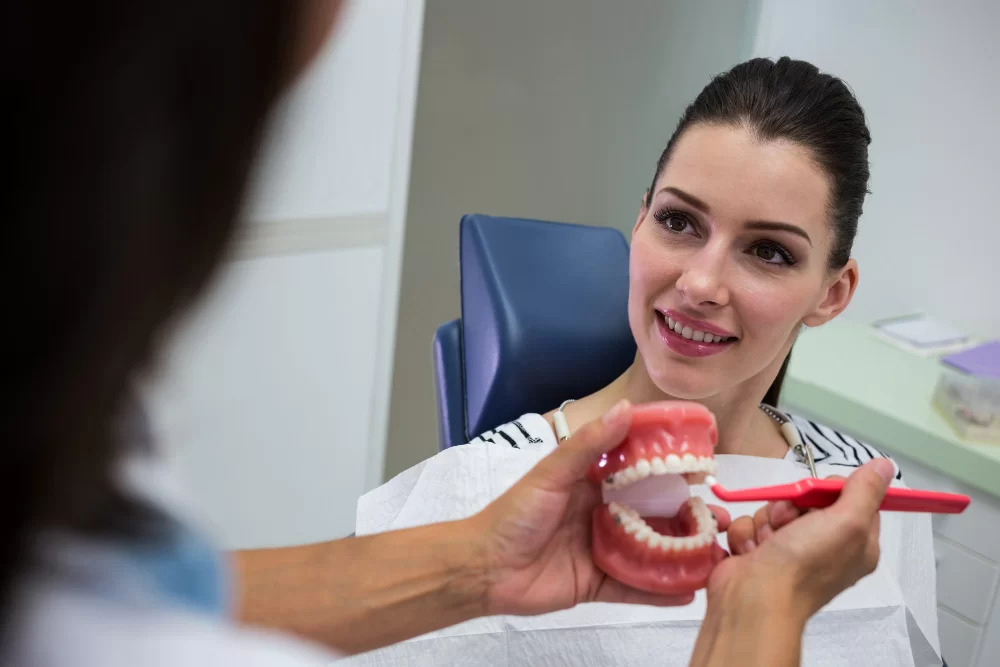Prosthodontics Treatment:
Overview of Prosthodontics: Prosthodontics is a dental specialty that deals with the diagnosis, treatment planning, rehabilitation, and maintenance of oral function, comfort, appearance, and health of patients with missing teeth or compromised oral structures. Prosthodontic treatments aim to restore the natural form and function of the teeth and surrounding oral tissues.
Prosthodontic Procedures: Prosthodontic procedures encompass a wide range of treatments, including dental crowns, bridges, dentures, dental implants, and veneers. These interventions address various dental issues, such as tooth loss, decay, trauma, or congenital defects, with the goal of improving both the function and aesthetics of the patient’s smile.
Customized Treatment Plans: Prosthodontics dentists develop customized treatment plans based on the unique needs and conditions of each patient. Through careful examination and diagnostic assessments, they determine the most suitable prosthetic solutions to achieve optimal oral health and cosmetic outcomes.
Collaboration with Other Specialists: Prosthodontists often collaborate with other dental specialists, such as oral surgeons, periodontists, and orthodontists, to ensure a comprehensive approach to treatment. This interdisciplinary collaboration is particularly important in cases requiring a combination of procedures for optimal results.
Prosthodontics Dentist:
Specialized Expertise: A prosthodontics dentist is a highly trained and specialized professional who has completed advanced education and clinical training in prosthodontics. Their expertise extends beyond general dentistry, focusing specifically on the restoration and replacement of teeth to achieve optimal oral function and aesthetics.
Comprehensive Treatment Planning: Prosthodontics dentists are skilled in comprehensive treatment planning, taking into account various factors such as the patient’s oral health, jaw function, and cosmetic concerns. This meticulous planning ensures that the chosen prosthodontic interventions align with the patient’s overall dental goals.
Advanced Prosthodontic Techniques: Prosthodontists employ advanced techniques and technologies in their practice. From digital impressions to computer-aided design and manufacturing (CAD/CAM), these professionals stay abreast of technological advancements to provide state-of-the-art prosthodontic solutions.
Patient-Centered Approach: A prosthodontics dentist adopts a patient-centered approach, prioritizing effective communication and collaboration with the individual seeking treatment. They ensure that patients are actively involved in the decision-making process, addressing concerns and aligning treatment plans with the patient’s preferences and expectations.
Prosthodontics Veneers:
Introduction to Veneers: Prosthodontics veneers are ultra-thin, custom-made shells of tooth-colored materials (often porcelain) designed to cover the front surface of teeth. These veneers are a popular cosmetic dentistry option, capable of transforming the appearance of teeth by improving their color, shape, size, and overall alignment.
Cosmetic Enhancements: Prosthodontics veneers are commonly used to address cosmetic concerns, including stained or discolored teeth, chipped or worn enamel, and irregular tooth shapes. The veneers are meticulously crafted to blend seamlessly with the natural teeth, providing a harmonious and aesthetically pleasing smile.
Minimal Tooth Preparation: Unlike some other dental procedures, prosthodontics veneers require minimal tooth preparation. The thin nature of the veneers allows for conservative enamel removal, preserving the structural integrity of the underlying teeth while still achieving significant cosmetic improvements.
Customization and Natural Appearance: Prosthodontics veneers are customized to match the color, translucency, and shape of the patient’s natural teeth. This attention to detail ensures that the veneers appear natural and seamlessly integrate with the surrounding dental structures, providing a beautiful and authentic-looking smile.
Durable and Long-Lasting:
Prosthodontics veneers are known for their durability and longevity. With proper care and maintenance, veneers can last for many years, making them a reliable and effective solution for individuals seeking lasting cosmetic enhancements.
Conclusion
Prosthodontics treatment, administered by skilled prosthodontics dentists, plays a pivotal role in restoring and enhancing the form and function of the teeth. Among the various prosthodontic interventions, veneers stand out as a versatile and effective cosmetic solution, transforming smiles with minimal tooth preparation and long-lasting results. Whether addressing functional issues or cosmetic concerns, prosthodontics remains at the forefront of dental innovation, bringing smiles to life and empowering individuals to confidently showcase their oral health and aesthetic appeal.

